CBSE Sample Papers for Class 12 Biology Set-10
Class 12thCBSE Sample Papers for Class 12 Biology Set-10
CBSE Sample Papers for Class 12 Biology Set 10 with Solutions
Time : 3 Hours
Maximum Marks : 70
General Instructions:
- All questions are compulsory.
- The question paper has five sections and 33 questions. All questions are compulsory.
- Section-A has 16 questions of 1 mark each; Section-B has 5 questions of 2 marks each; Section-C has 7 questions of 3 marks each; Section-D has 2 case-based questions of 4 marks each; and Section-E has 3 questions of 5 marks each.
- There is no overall choice. However, internal choices have been provided
in some questions.
A student has to attempt only one of the alternatives in such questions. - Wherever necessary, neat and properly labelled diagrams should be drawn.
Section A
Question 1.
A cancer patient was admitted to the hospital. Out of the four
options given below, select the substance given to the patient in order to
activate their immune system and destroy the tumour?
(a) Histamine
(b)
Morphine
(c) Interleukin
(d) a-interferon
Answer:
(d) Cancer
patients are injected with substance called biological response modifiers like
a-interferon, which activate their immune system and help in destroying the
tumour.
Question 2.
Which one of the following is the most productive
ecosystem?
(a) Desert
(b) Grassland
(c) Temperate forest
(d)
Tropical rainforest
Answer:
(d) Tropical rainforest shows the maximum
diversity and also the maximum productivity. More solar energy and resources are
available in tropics which promotes higher productivity.
Question 3.
Give the name of two hormones A and B in the figure given
below.
(a) FSH and GH
(b) LH and androgens
(c) GH and LH
(d) GH and lactin
Answer:
(b) The LH hormone acts on Leydig cells which
stimulate synthesis and secretion of androgens.
Question 4.
Nanda Devi biosphere reserve is found in
(a)
Uttarakhand
(b) Assam
(c) Andhra Pradesh
(d) Himachal Pradesh
Answer:
(a) Nanda Devi biosphere reserve is found in Uttarakhand.
![]()
Question 5.
After birth, colostrum released from mammary glands is rich in
which of the following constituents?
(a) Fats
(b) Proteins
(c) Proteins
and antibodies
(d) Proteins and fats
Answer:
(c) After birth, the first
milk released by mammary glands is called colostrum. It is released for 2 – 3
days. It is thin, yellowish fluid containing cells from the alveoli of glandular
tissue of mammary glands and is rich in protein, antibodies, but low in
fats.
Question 6.
Which of the following bp is correct for human genome?
(a)
2.2 × 104 bp
(b) 3 × 109 bp
(c) 6 × 109
bp
(d) 20,000 – 25,000 bp
Answer:
(b) Human genome has 3.1647 million
nucleotide base pairs (3 × 109bp). The average gene size is 3000 base
pairs. The human genome consists of about 20,500 genes.
Question 7.
Which of the following is the ultimate 1 energy source for all
ecosystem?
(a) Producer
(c) Solar radiation
(b) Carbohydrate
(d)
Organic molecule
Answer:
(c) The ultimate energy source of all ecosystem
is solar radiation.
Question 8.
Following pedigree chart shows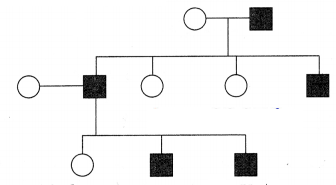
(a) character is carried by Y-chromosome
(b) character is
sex-linked recessive
(c) character is sex-linked dominant
(d) character is
recessive autosomal
Answer:
(a) In the given pedigree chart only males are
affected. So, it can be easily infered that the given trait is connected to
Y-chromosome.
Question 9.
Tetanus is an infection caused by Clostridium tetani. Identify
the treatment and the type of immunity developed from the given table.
| Remedy/Treatment | Immunity | |
| (a) | Antitoxins | Passive |
| (b) | Vaccines | Active |
| (c) | Colostrum | Active |
| (d) | Vaccines | Passive |
Answer:
(a) Tetanus infection is cured by tetanus antitoxin, which is
called passive immunisation.
Question 10.
Which of the following bacterium is used for the isolation of
the enzyme Taq polymerase and restriction endonuclease, respectively?
| Taq polymerase | Restriction endonuclease | |
| (a) | Thermus aquaticus | Haemophilus influenzae |
| (b) | Agrobacterium tumefaciens | Escherichia coli |
| (c) | Streptomyces albus | Thermus aquaticus |
| (d) | Escherichia coli | Haemophilus influenzae |
Answer:
(a) Taq polymerase is isolated from Thermus aquaticus and
restriction endonuclease is isolated from Haemophilus influenzae.
Question 11.
On the rocky sea coasts of Scotland, the larger and
competitively superior barnacle Balanus dominates the intertidal area and
excludes the inferior barnacle Chathamalus from that zone. The kind of
interaction exhibited in this case is
(a) predation
(b) parasitism
(c)
competition
(d) mutualism
Answer:
(c) Competition keeps the population
of inferior species under check. Superior barnacle, Balanus nearly excluded the
smaller barnacle, Chathamalus.
Question 12.
The figure below shows the cross of blood group of
parents.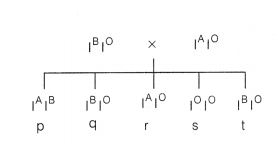
The offspring produced have the following blood groups.
Choose the correct result that the child has blood group that is heterozygous
and co-dominant from the given table.
| Co-dominant | Heterozygous | |
| (a) | s | t |
| (b) | q | r |
| (c) | p | q |
| (d) | r | p |
Answer:
(c) Child p is co-dominant for blood group AB, child q and child t
are heterozygous dominant for blood group B, child r is heterozygous dominant
for blood group A and child s is homozygous recessive for blood group O.
Question Nos. 13 to 16 consist of two statements- Assertion (A) and Reason
(R). Answer these questions selecting the appropriate option given below
(a)
Both Assertion and Reason are true and Reason is the correct explanation of
Assertion
(b) Both Assertion and Reason are true, but Reason is not the
correct explanation of Assertion
(c) Assertion is true, but Reason is
false
(d) Assertion is false, but Reason is true
Question 13.
Assertion (A) : Pollen grain of angiosperm is considered as
the male gametophyte.
Reason (R) : Pollen grain contains stigma, syte and
ovary.
Answer:
(c) Assertion is true, but Reason is false. It can be
corrected as
Pollen grain does not contain the syle, stigma and ovary. These
are parts of the flowers’s female reproductive part, i.e. gynoecium.
Question 14.
Assertion (A) : Hind II is a restriction enzyme.
Reason
(R) : It is responsible for the cleavage of the sequence.
Answer:
(a) Both
Assertion and Reason are true and Reason is the correct explanation of
Assertion.
Hind II is a restriction endonuclease that cleaves the whole
sequence. It was first discovered and hence, isolated from Haemophilus
influenzae. It produces blunt ends.
Question 15.
Assertion (A) : Each antibody is represented by H2
L2.
Reason (R) : Each antibody molecule has four nucleotide
chains, two small called light chains and two longer called heavy chains.
Answer:
(c) Assertion is true, but Reason is false.
Each antibody molecule
is represented as H2L2, because it has four peptide
chains, i.e. two small chains called light chains and two longer chains called
heavy chains.
Question 16.
Assertion (A) : In a wildlife sanctuary, collection of
timber, harvesting of minor forest products and private ownership rights are
allowed.
Reason (R) A : sanctuary is a protected area meant for the
conservation of both flora and fauna where cultivation of land is permitted.
Answer:
(c) Assertion is true, but Reason is false.
A wildlife sanctuary
is a protected area which is meant for the conservation of fauna only.
The
activities like collection of forest products, harvesting of timber, private
ownership of land, etc. are allowed in wildlife sancturies.
Section B
Question 17.
‘β-galactosidase enzyme is considered a better selectable
marker’. Justify the statement.
Answer:
β-galactosidase is a better
selectable maker, as it allows the selection of differentiation between
recombinants and non-recombinants on the basis of their ability to produce
colour in the presence of a chromogenic substrate. Because the selection of
recombinants due to inactivation of antibiotic resistant gene is a tedious and
time taking process as latter involves growing the bacteria simultaneously on
two antibiotics containing media.
Question 18.
In the figure given below, parts A and B are labelled and
shows a HIV virus.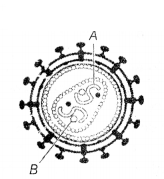
(i) Name the parts A and B that are surrounded by the protein
coat.
(ii) State how is it possible for HIV virus having no DNA infects the
host cell which possess viral DNA.
Answer:
(i) Part A represents RNA,
while part B represents the enzyme of reverse transcriptase.
(ii) HIV virus have RNA as their genetic material. After taking entry into the body of a person, the virus reaches the macrophages. Where, the RNA gets replicated to form viral DNA by using an enzyme reverse transcriptase. The viral DNA now gets incorporated into the host’s cell DNA and directs the infected cells to produce virus.
Question 19.
The given below graph shows the interaction between two
species ‘X’ and ‘T’. Interpret the graph and explain the interaction shown. Also
give the possible species name where the following interaction is
observed.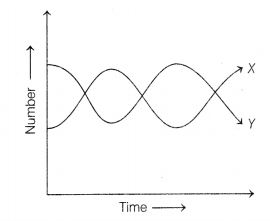
Answer:
The graph shows the interaction between two
species X and Y in which one species is a predator whereas another species is a
prey. The following interaction is observed in between lion and deer, herbivores
and grass, etc.
Question 20.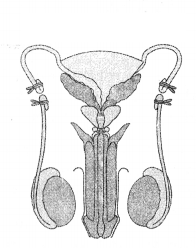
(i) What does the above process known as?
(ii) Explain the
mode of action of this process.
Answer:
(i) The above process is known as
vasectomy which is a contraceptive method that comes under the surgical or
sterilisation methods.
(ii) The vasectomy is usually done in men where a small part of the vas deferens is cut and tied up through a small incision on the scrotum in males to prevent sperm from entering in the urethra.
Question 21.
Given below is the diagram that shows a pair of homologous
chromosomes during meiosis.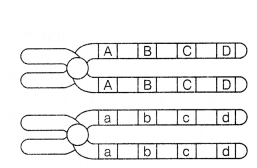
(i) Which of the genes will show maximum crossing over?
(ii) How does the strength and weakness of linkage depend on linked genes?
Or
Is haemophilia in humans a sex-linked or autosomal disorder? Workout a
cross in support of your answer.
Answer:
(i) The maximum crossing over is
seen in genes A and d, and a and D. Since, A and d, and a and D are located far
away, from one another.
(ii) The strength of the linkage increases as the distance between two linked
genes decreases. The linkage becomes weaker with the increase in the distance
between genes.
Or
Haemophilia is an X-linked recessive disease. The gene
responsible for haemophilia is located on X-chromosome and because males have
only single copy of X-chromosome with no alternate normal allele, they are
always affected. While, in case of female, they can be carrier of the disease
but being affected is a rare case.
Suppose a carrier female and normal male
marries . each other then the genotype of their offspring/children will
be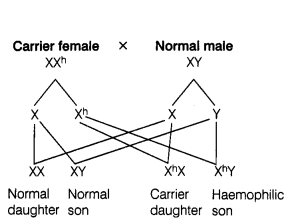
Hence, from the cross, it can be concluded that haemophilia
is a X-linked recessive disorder in which the son inherit the disease from
mother, while daughters from their father.
Section C
Question 22.
(i) Identify parts A and B from the given diagram. Also
mention their role in male reproductive system.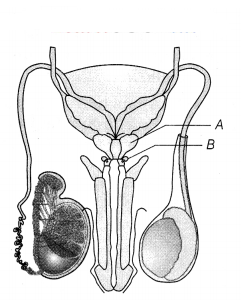
(ii) Why are scrotum situated outside the abdominal cavity?
Also mention the path followed by sperm.
Answer:
(i) Part A shows the
prostate gland and part 6 shows the Bulbourethral gland. Both prostate gland and
Bulbourethral gland are male accessory gland. Secretion of these glands
constitutes the seminal plasma which is rich in fructose, calcium and certain
enzymes. The secretion of Bulbourethral gland also helps in the lubrication of
penis.
(ii) Scrotum is situated outside the abdominal cavity as it is essential for spermatogenesis, i.e. formation of sperm which requires the temperature of about 2 – 2.5°C lower than the internal body temperature.
The path followed by sperm is as follows
Seminiferous tubules → Rete
testis → Vasa efferentia → Epididymis → Vas deferens → Ejaculatory duct →
Urethra.
Question 23.
Explain the uses of plasmid DNA, recognition sequence and gel
electrophoresis in biotechnology.
Answer:
The uses of plasmid DNA,
recognition sequences and gel electrophoresis are as follows
Plasmid DNA : It
is used for constructing recombinant DNA by ligating the alien piece of DNA with
it. It is used as cloning vector and helps in the selection of recombinants from
non-recombinants.
Recognition sequences : These are the specific base sequences of DNA where restriction enzyme cuts the DNA. These are utilised to extract the desired gene or fragments from DNA molecules.
Gel electrophoresis : It is a techinque used to separate the DNA fragments according to their size through seiving effect of the gel.
Question 24.
Seed is the basis of our agriculture. Dehydration and
dormancy of mature seeds are crucial for storage of seeds. It can be used as
food throughout the year and also to raise crop in the next season.
(i) Why
does it is crucial for seed to undergo dormancy?
(ii) Give an example of a
very old viable seed which is excavated from Arctic Tundra, in which the seed
germinated and flowered after an estimated record of 10,000 years of
dormancy.
Answer:
(i) Dormancy is a condition in which the water content
reduces, seed become dry, the metabolic activity of embryo slows down and the
seed may enter into a state of inactivity. It is crucial for seed to undergo
dormancy in order to escape unfavourable environment such as unsuitable
temperature, unadequate water/ moisture, oxygen, etc.
(ii) The oldest viable seed is that of a lupine, Lupinus ariticus, excavated
from Arctic Tundra.
In order to obtain maximum marks,1 following tips should
be followed Points Car|didate should start his answer by defining the term
dormancy and then its importance.
Question 25.
Study the hypothetical template strand given below.
(i) Construct a complete transcription unit with promoter and
terminator on the basis of the above strand.
(ii) What is the name of the
enzyme that transcribed this RNA?
Answer:
(i) The RNA molecule given in
question should be
As RNA have uracil in place of thymine.
For given RNA, the
transcription unit will be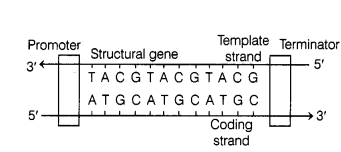
(ii) The process of copying genetic information from one
strand of DNA into RNA is called ‘transcription’. Transcription is catalysed by
‘DNA dependent RNA polymerase’.
Question 26.
Double fertilisation is reported in plants of both, castor
and groundnut. However, the mature seeds of groundnut are non-albuminous and
castor are albuminous. Explain the post-fertilisation events that are
responsible for it.
Answer:
Double fertilisation is reported in both
castor and groundnut, but their mature seeds are different in terms of
endosperm. Endosperm may be completely utilised by the developing embryo before
the maturation of seeds as in groundnut.
Such seeds are called non-albuminous or non-endospermic seeds. In some seeds, a portion of endosperm remains in the seed and is used up during seed germination. Such seeds are called albuminous or endospermic seeds, e.g. castor.
Question 27.
Population is a set of individuals of a particular species,
which are found in a particular geographical area and can interbreed. Population
ecology is an important area of ecology because it links ecology to population
genetics and evolution.
(i) Write the importance of measuring the size of a
population in a habitat or an ecosystem.
(ii) Explain with the help of an
example, how the percentage cover is a more meaningful measure of population
size than mere numbers.
Or
Ecological competition is the struggle between
two organisms for the same resources within an environment. Resources are
components of the environment, they are required for survival and reproduction
such as food, water, shelter, light, territory and substrate.
(i) In which
process, the fitness of one species (measured in terms of its V the intrinsic
rate of increase) is significantly lower in the presence of another superior
species?
(ii) In which mechanism, species facing competition might evolve
mechanism that promotes co-existence rather than exclusion?
(iii) Level of
competition between species depends on which factors?
Answer:
(i)
Measurement of population in a habitat determines the relative abundance of a
particular species and its effect on the available resources of that particular
habitat.
(ii) The percentage cover is more meaningful measure of population size than mere numbers because the relative abundance of a species is not only determined by number of individuals, but by the relative abundance in both biomass and number.
For example, in a unit area, the number of grass species or relative
abundance in number is high, but not the relative biomass, if the same area has
one or two Ficus benghalensis tree, it is very low in relative abundance, but
high in relative abundance of biomass.
Or
(i) Competition is best defined
by the fitness of one species as compared to other competitive species. It is
the process in which the fitness of one species is significantly lower in the
presence of another superior competitior species.
(ii) Species facing competition might evolve mechanism that promotes co-existence rather than exclusion. One such mechanism is resource partitioning.
(iii) Level of competition between species depends on availability of resources, population density and group interaction of organism.
Question 28.
A considerable amount of lactose is added to the growth
medium of E. coli. How is the lac operon switched on in the bacteria? Mention
the state of the operon when lactose is digested.
Answer:
In lac operon,
when lactose is added, it enters the cell wall with the help of permease, a
small amount of which is already present in cell. Lactose binds itself to active
repressor and changes its structure. The repressor now fails to bind to the
operator.
The RNA polymerase starts transcription of operon by binding to promoter site-R All the three enzymes for lactose metabolism are synthesised.
After some time, when whole lactose is consumed, ‘there is no inducer present to bind to the repressor. Due to this, the repressor becomes active again, attaches itself to the operator and finally switches off the operon.
Section D
Q. Nos. 29 and 30 are case-based questions. Each question has 3 subparts with internal choice in one subpart.
Question 29.
Study the given karyotype and answer the questions that
follows.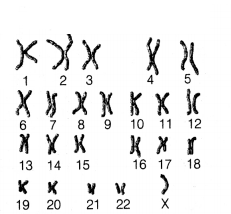
(i) On the basis of the above karyotype, what conclusion can
you draw about the disorder? [1]
(ii) If someone have been diagnosed with
this disorder, what are the symptoms shown by the individual? [1]
(iii) Give
the cause of this disorder. [2]
Or
(iii) Mention any two other chromosomal
disorders. [2]
Answer:
(i) On the basis of the given karyotype, the
disorder is Turner’s syndrome.
(ii) The affected individual (females) are sterile as ovaries are
rudimentary.
They lack secondary sexual characteristics, have poor breast
development, small uterus, puffy fingers, etc.
(iii) The Turner’s syndrome is
caused due to the absence of one of the X-chromosome (i.e. 45 with XO).
Or
(iii) The other chromosomal disorders are
(a) Klinefelter’s syndrome
caused due to the presence of additional copy of X- chromosome.
(b) Down’s
syndrome caused due to the additional copy of 21st chromosome (i.e. trisomy) in
humans.
Question 30.
The data below shows the symptoms of common cold by an
individual after the exposure of causative virus.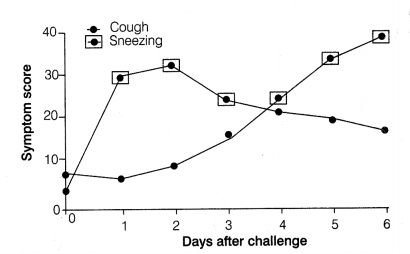
(i) How will the virus affect the immune system? [1]
(ii)
How does the virus enter the body of an individual? [1]
(iii) With reference
to the above graph explain the pattern of sneezing in common cold. [2]
Or
(iii) How do antibiotics help to fight common cold? [2]
Answer:
(i)
Rhinovirus activates the immune system causing the release of cytokines from the
affected cells to attract immune cells.
(ii) The virus enters via the upper respiratory tract. It generally gets into the nasal passage through inhalation of particles or touching of nose with contaminated hand.
(iii) From the given graph, it is shown that the severity of sneezing
increases rapidly, peaking 2 – 3 days after the exposure of cold causing virus
with a mean duration of symptoms of 7 – 10 days.
Or
(iii) As cold is
caused by rhinovirus so, it does not make sense to use antibiotics, as
antibiotics do not work against viruses.
Section E
Question 31.
Observe the schematic representation of oogenesis given
below.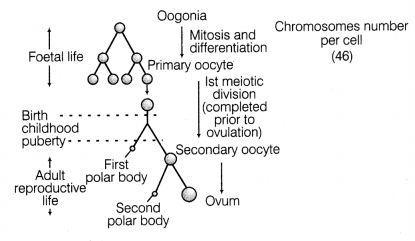
(i) Explain and illustrate the phases in oogenesis.
(ii)
After the formation of secondary oocyte, if sperm does not fertilise the egg,
what will happen then? Explain.
Or
Study the diagrammatic presentation of
various events during a menstrual cycle given below and answer the questions
that follows.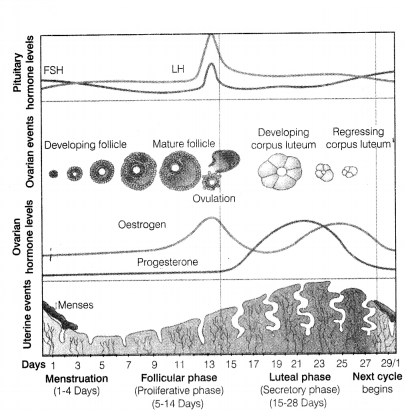
(i) The released ovum present in Fallopian tube gets
fertilised with sperm, how will it affect the menstrual cycle?
(ii) LH
released by the pituitary gland become abnormally low at day 14 due to unknown
reasons. Explain its impact on ovulation stating the reasons.
(iii) If
progesterone is absent or low in level, will menstruation occur? Justify your
answer.
Answer:
(i) Oogenesis is the process of formation of a mature
female gamete. The production of eggs in females begins before birth, i.e.
during the embryonic development stage, but is completed only after
fertilisation. It takes place in ovaries.
The process undergoes following
phases
(a) Multiplication phase Cells of germinal epithelium undergo mitotic division producing undifferentiated germ cells called oogonia or egg mother cells within each foetal ovary. These cells start dividing and enter prophase-I of meiotic division and get temporarily arrested at this stage. These cells are known as primary oocytes.
(b) Growth phase Each primary oocyte then gets surrounded by a single layer of granulosa cells and is called the primary follicle. About two million of these follicles exist in females before birth. A large number of these follicles degenerate during the phase from birth to puberty. Therefore, at puberty only 60,000-80,000 primary follicles are left in each ovary. The primary follicles get surrounded by more layers of granulosa cells and a new theca to form secondary follicles.
(c) Maturation phase During this phase, the secondary follicle transforms into tertiary follicle. These are characterised by a fluid cavity called antrum. The theca layer is organised into an inner theca interna and an outer theca externa.
The primary oocyte within this tertiary follicle grows in size. The fully grown primary oocyte completes its first meiotic division producing two daughter nuclei in which larger haploid cell is called secondary oocyte (ovum) and the tiny one is called first polar body. The secondary oocyte retains bulk of the nutrient rich cytoplasm of primary oocyte.
(ii) If the secondary oocyte is not fertilised, it passes into the uterus as
an immature egg and the lining of the uterus, i.e. endometrium is shed during
menstruation.
Or
(i) After fertilisation of ovum with sperm, the zygote is
formed. The fertilised eggs stay in the Fallopian tube for about 3 to 4 days.
But within 24 days, it starts to divide and move towards the uterus for
implantation. As a result of change in different hormone levels and need of
thick endometrium for zygote to implant, menstrual cycle stops till the birth of
the baby.
(ii) If LH released by the pituitary gland become low, the ovulation will not occur. As the leutinizing hormone surge, induces the rupture of Graafian follicle and thereby the release of ovum.
(iii) As progesterone prepares endometrium for pregnancy its absence or low level leads to heavy menstrual bleeding, the uterus will not be able to implant the foetus. Due to this miscarriages can happen. Thus, this female will not be able to concieve a child.
Question 32.
Researchers have been working for decades to bring gene
therapy to the clinic, yet very few patients have received any effective gene
therapy treatments. The earliest method of gene therapy, often called gene
transfer or gene addition, was developed to introduce a new gene into cells to
help in fighting a disease.
(i) List two advantages of using gene therapy for
treating disorders.
(ii) For treating ADA deficiency, the gene therapy is
carried out. How is this carried out and help the patient to overcome the
disorder?
(iii) If the gene therapy is performed at embryonic stages, how
will this have a positive effect on the children?
Or
The biological
activity of insulin was tested using an assay in in vitro, using HepG2 cell
under hyperglycemic conditions.
In this assay, 3 concentrations were used for
the standard insulin and crude biosynthesised human insulin : low (50 μg/mL),
medium (100 μg/mL) and high (150 μg/mL).
A graph illustrating the above
conditions are given below.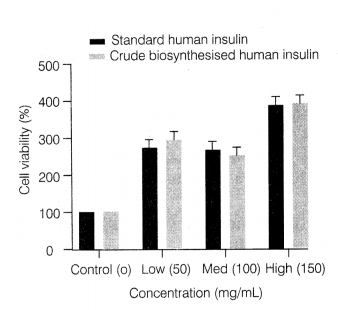
(i) By studying the above graph discuss the efficiency of
crude biosynthesised human insulin at low concentration, i. e. 50 μg/mL.
(ii)
At which concentration, both the insulin are equally efficient.
(iii) Using
the above information, suggest why we should always use control in assay?
Answer:
(i) Advantages of using gene therapy for treating disorders are as
follows
(a) Sustained, local delivery with regulated gene expression.
(b)
It is less expensive as one gene can give rise to large number of protein
molecules.
(ii) The disorder is caused due to the deletion of the gene for adenosine deaminase. In gene therapy, lymphocytes from the blood of the patient are grown in culture outside the body. A functional ADA cDNA (using a retroviral vector) is then introduced into these lymphocytes which are subsequently returned to the patient.
As these cells are short lived, the patient requires periodic infusion of such genetically engineered • lymphocytes.
(iii) If the functional ADA gene is isolated from bone marrow and is
introduced at early embryonic stages, the deficiency could be permanently
cured.
Or
(i) The efficiency of crude biosynthesised human insulin is
better than standard one. As we can see the cell (HepG2), viability is more in
hyperglycemia condition in the crude biosynthesised insulin case.
(ii) At high (150 µg/mL), both the insulin are equally efficient as in both the cases HepG2 cells are equally viable.
(iii) Control is necessary while performing assay as it helps to check the effects of insulin at different concentration.
Question 33.
State the modifications of forelimb in animals as an example
of homology.
Or
Write the characteristics of Ramapithecus, Dryopithecus,
Neanderthal man, Australopithecus, Homo habilis.
Answer:
The forelimb of
vertebrates are pentadactyl, i.e. consist of same bones humerus, radius, ulna,
carpals, metacarpals and phalanges, but differ in their function in different
organisms.
The forelimbs of the following animals get modified as shown below
- Whale are modified for swimming.
- Bat and birds are modified for flying.
- Horse are modified for running.
- Frog are modified for leaping.
- Man are modified for grasping.
This indicates common ancestry and homology based on divergent evolution.
Or
The characteristics are as follows
| Human ancestors | Time of origin | General features |
| Dryopithecus | 20 – 25 mya | Ape-like, hairy, ate soft fruits and leaves. Arms and legs of same length, large brain. |
| Ramapithecus | 14 – 15 mya | More man-like, walked more erect, teeth like modern man. |
| Home sapiens neanderthalensis (Primitive man) | 1,00,000 – 40,000 year ago | Known as Neanderthal man. Fossils found in East and Central Asia, brain size 1400cc, used hides to protect body, buried their dead. They became extinct 25,000 years ago. |
| Australopithecus (The first ape man) | 2 mya | Probably lived in East African grasslands and ate fruits, hunted with stones weapons, brain capacity was 400 – 600 cc. |
| Homo habilis (Handy man) | 1.2 – 1.5 mya | Fossils found in East Africa , first hominid, i.e. human-being like, brain capacity 650 – 800 cc, did not eat meat. |